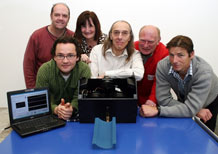
From l to r, Roger Perrett (electronic workshop technician), Dr Raphael Matelon, Dr Lesley Wears, Professor Dave Newman, Pete Gerry (mechanical workshop technician) and Dr Luke Savage.
Exeter tests new malaria diagnosis technique in Kenya
An engineer from the University of Exeter has gone to Kenya to provide engineering support during the testing of a new technique for diagnosing malaria.
Dr Raphael Matelon will be spending five weeks in a remote village on the edge of Lake Victoria, where a team hopes to test 1,500 local people using two new diagnostic devices.
The first instrument, manufactured by Philips, requires a fingerprick blood sample. The second, manufactured in-house at the University, is a non-invasive bloodless technology operating on the same principle which uses a laser to a scan the blood supply beneath the fingernail.
After three years of laboratory research, the devices are now ready to be put to the ultimate test in the field. Dr Raphael Matelon will be in Kenya with colleagues from KIT, Amsterdam. They will work closely with the ICIPE health clinic in the village of Mbita, where they will be based. The team will offer tests to local men, women and children. Those that are found to have malaria will receive treatment from the health centre.
Dr Raphael Matelon of the University of Exeter left for Kenya on Saturday 15 November. He says: “We’ve worked hard to get this far so it’s exciting that we’re ready to test the technique for real. I’m looking forward to getting to know the local people and working with the health centre. For holiday makers, visiting Kenya during a malaria outbreak in the rainy season would not be a very attractive prospect, but conditions are ideal for our study.”
After more than a century high-power microscopy is still the most trusted method available for malaria diagnosis. It is however very time-consuming and requires basic laboratory facilities and specialist medical skills rarely available in villages in the rural areas of malaria endemic countries. Over the last decade rapid diagnostic tests RDTs have been developed which allow for faster (20 minutes) diagnosis in the field but these use a chemical agent to detect antigens associated with the malarial parasite which unfortunately requires they be stored and used within a limited temperature range. Each disposable test also costs between $1.50 and $4.50 which is a heavy financial burden on developing countries. In consequence, many communities where malaria is having a severe impact on health do no testing but instead give anti-malaria drugs as a matter of course to all young children who have a fever. This has contributed to the malarial parasite becoming increasingly resistant to the common anti-malaria drugs. Malaria is a disease for which there is still no vaccine.
The new devices being tested operate on a totally different principle to RDTs. Researchers from the Universities of Exeter and Coventry together with the Royal Tropical Institute (KIT), Department of Biomedical Research in Amsterdam who developed this new test technique believe it will challenge the rapid diagnostic tests (RDTs) currently used in the field. Early results suggest that the technique could be as effective as RDTs but far faster and cheaper, making it a potentially viable alternative for malaria diagnosis.
Both devices use magneto-optic technology (MOT) to detect haemozoin, a waste product of the malarial parasite, in the blood. Haemozoin crystals are weakly magnetic and have a distinct rectangular form. They also exhibit optical dichroism, which means that they absorb light more strongly along their length than across their width. When aligned by a magnetic field they behave like a weak Polaroid© sheet such as used in sunglasses. This new technology takes advantage of these properties to give a precise reading of the presence of haemozoin in a blood sample. The research program has created instrumentation which gives a positive or negative reading for malaria in less than a minute.
Professor Dave Newman of the University of Exeter’s School of Engineering, Computing and Mathematics, project leader, added: “There is an urgent need for new diagnostic tests for malaria that do not rely on chemical or biological reagents or laboratory support and which can be realised in a small portable package. The early results from our devices are very promising and hugely exciting. The instrument requiring a fingerprick blood sample has performed well in pre-clinical trials with transported blood samples but the non-invasive instrument can only be meaningfully tested with patients present.”
This research project is funded under the European Commission Framework 6 Program.
Date: 17 November 2008
